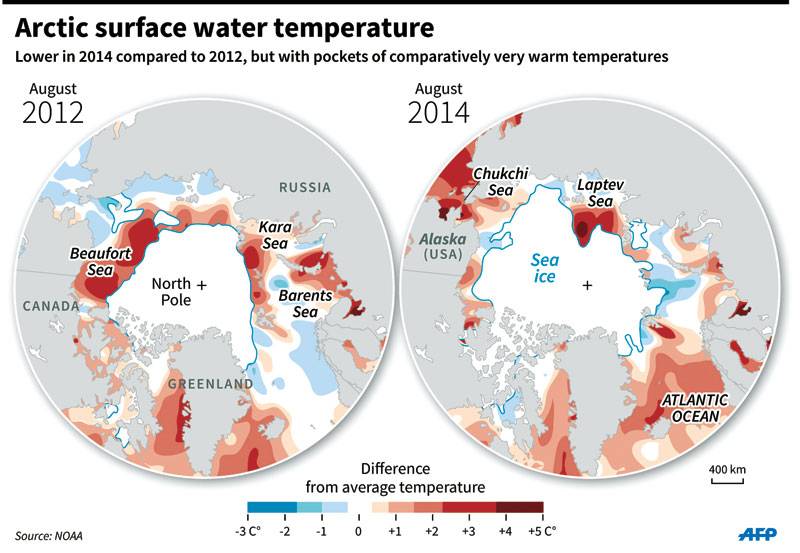MIAMI - Record high temperatures in Alaska, below average snow cover across the Arctic and excess summer ice melting in Greenland were observed this year by scientists, raising new concerns about global warming.
The annual Arctic Report Card, compiled by 63 scientists in 13 countries and updated each year since 2006, was released on Wednesday at the American Geophysical Union meeting in San Francisco.
While the report found that the Arctic is still warming at more than twice the rate of lower latitudes, indicating that the trend known as Arctic Amplification is continuing, it contained few surprises for scientists.
“We can’t expect records every year. It need not be spectacular for the Arctic to continue to be changing,” said lead author Martin Jeffries, Arctic science advisor and program officer for Arctic and Global Prediction at the Office of Naval Research in Arlington, Virginia.
Air temperature in the Arctic continued to get warmer compared to the average of the past 30 years, which is important because these air temperatures act as both an indicator and driver of regional and global changes, altering habitats for polar bears which struggle to survive when there is less sea ice.
“Climate change is having a disproportionate effect on the Arctic. In the past 30 years the Arctic has been getting greener, warmer, increasingly more accessible to shipping, energy extraction and fishing,” said Craig McLean, acting assistant administrator at the National Oceanic and Atmospheric Administration (NOAA).
“These changes due to rising greenhouse gases are creating major challenges.” There were some small improvements last year, including a slight thickening of ice in the Arctic and only the sixth lowest amount of sea ice since satellite observations began in 1979.
However, the report said that ongoing study has found that year-to-year and regional differences in air temperatures over time are often “due to natural random variability.” The report spans October 2013 to September 2014. In that time frame, there were extreme cold temperatures in eastern North America and central Russia, along with unusually warm air in Alaska and northern Europe.
“Alaska recorded temperature anomalies more than 18 degrees Fahrenheit (10 degrees Celsius) higher than the January average,” it said.
Snow cover across the Arctic during the spring was below the 1981-2010 average, and new record lows were seen in April for Eurasia.
North America’s snow cover in June was the third lowest on record, and “snow disappeared three to four weeks earlier than normal in western Russia, Scandinavia, the Canadian subarctic and western Alaska due to below average accumulation and above normal spring temperatures,” it said.
Despite a slight boost to ice thickness in the Arctic compared with 2013, there is “still much less of the oldest, thickest (greater than 13 feet or 4 meters) and most resilient ice than in 1988.”
Back then, the oldest ice made up 26 percent of the ice pack; now it is just 10 percent. Sea surface temperatures across the Arctic increased, particularly in the Chukchi Sea, northwest of Alaska, where temperatures are increasing at a rate of 0.9 degrees F (0.5 °C) per decade.
For most of the summer, melting along the Greenland ice sheet was above average, though the total mass of the ice sheet remained unchanged between 2013 and 2014.
As ice melts, its ability to reflect sunlight gets weaker, leading to even more ice loss. The ice in Greenland this summer was the second darkest since 2000, and August set a new low for reflectivity.
Tuesday, April 16, 2024
Rising temps seen as planet warms

4:14 PM | March 23, 2024
2:02 PM | March 16, 2024
Israeli Air Force finalizes preparations for possible attack on Iran
8:21 AM | April 16, 2024
Rising street crime alarms twin cities’ residents
April 16, 2024
Arrest made in deadly bus crash; owner still at large
April 16, 2024
Officials held responsible for patient’s drug denial
April 16, 2024
Police book 7 for torturing Christian family
April 16, 2024
Policing Reforms
April 15, 2024
Storm Safety
April 15, 2024
Deterrence Restored
April 15, 2024
IMF Challenges
April 14, 2024
Security Crisis
April 14, 2024
Suicide awareness
April 15, 2024
Biden’s dilemma
April 15, 2024
Over dependence on technology
April 14, 2024
Education reform call
April 14, 2024
Brain drain
April 14, 2024
ePaper - Nawaiwaqt
Advertisement
Nawaiwaqt Group | Copyright © 2024





